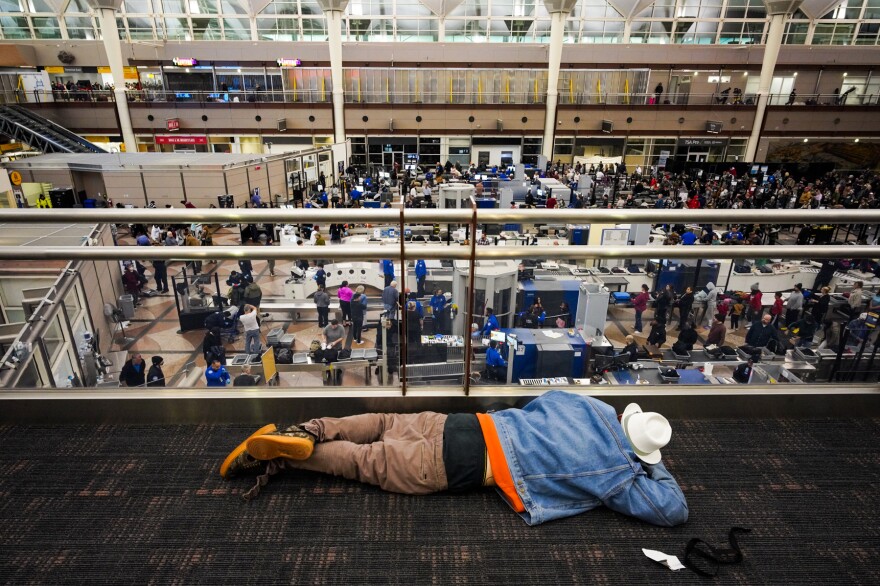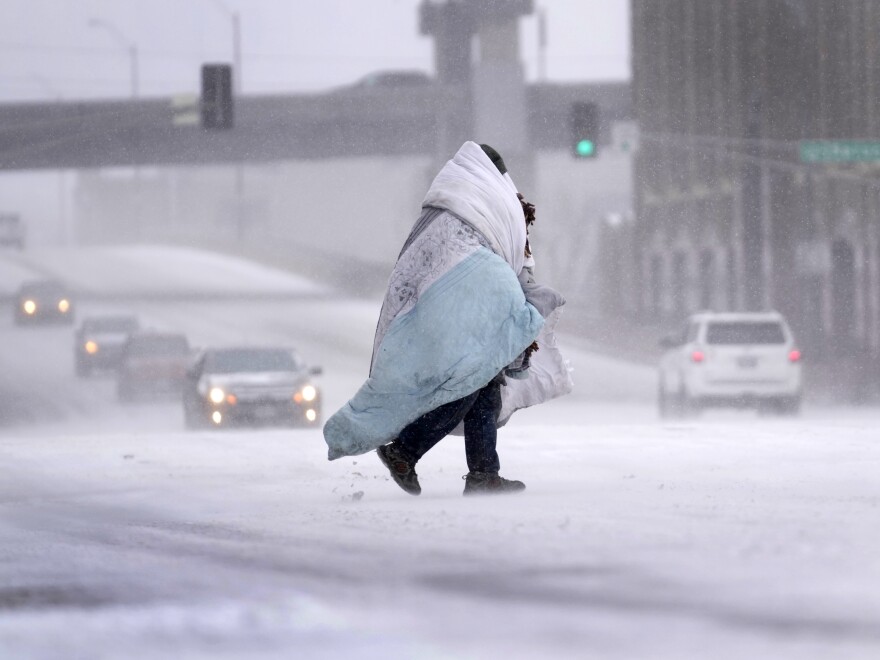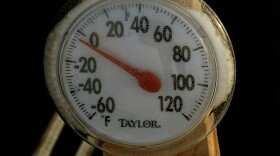Updated December 22, 2022 at 10:06 PM ET
On a day when millions of Americans were expected to be traveling for the winter holidays, a massive cold weather system marched across most of the contiguous United States, bringing record-breaking cold, gusty winds and dangerous precipitation to states from Montana to Alabama.
The National Weather Service estimated that much of the nation's 330 million residents were under some sort of winter weather alert on Thursday — a who's who of winter maladies from blizzards, snow squalls and ice storms to high winds, wind chill and hard freezes.
In its Thursday forecast, the NWS warned of "record-breaking cold and life-threatening wind chills over the Great Plains to overspread the eastern half of the Nation by Friday."
"This is really a very serious weather alert here," said President Biden, speaking to reporters Thursday morning in front of a national map of wind chill forecasts. "This is not like a snow day when you were a kid. This is serious stuff."
The cold front has moved so swiftly that temperatures across the Rocky Mountains plunged at record paces. On Wednesday night in Cheyenne, Wyo., the temperature dropped more than 30 degrees in just nine minutes.

Governors in Georgia, Kansas, Kentucky, North Carolina, Oklahoma, West Virginia and Wyoming declared states of emergency. In Indiana, Colorado and Missouri, governors activated the National Guard.
In Texas, where a 2021 winter storm overwhelmed the state's power grid and ultimately killed more than 200 people, officials said they expected the grid would hold up as forecasts called for cold weather but little precipitation.

"The grid is ready and reliable," said Peter Lake, chairman of the state's Public Utility Commission, in a Wednesday news conference. "We expect to have sufficient generation to meet demand throughout this entire winter weather event."
Still, cities and counties throughout the state have opened warming centers and short-term emergency shelters to help residents stay out of the cold.
On roads and highways from Wyoming to Missouri, wind and snow combined to lower visibility, making it dangerous to drive. Officials in multiple states, including Colorado and Illinois, urged drivers to avoid travel if at all possible.
Adding to the danger in low visibility conditions, Wyoming Gov. Mark Gordon says large vehicles in his state have been obstructing the road, due to the cold weather.
"The biggest challenge is that many of the semitrucks and some of the pickups have gelled up. Diesel fuel at a very low temperature doesn't flow properly and so trucks end up stalling out or not being able to move very quickly, so there are a lot of those on the road," Gordon told All Things Considered on Thursday.
His message to people who are venturing out on the road: "The most important thing is to make sure you're prepared. That means having warm clothes and making sure you have food if you do get stranded."
Across the country, forecasters warn that getting on the road altogether may be a bad idea.
"There's going to be enough snow combining with the wind to create treacherous driving conditions at a minimum," said Mike Bardou, a forecaster at the NWS office in Chicago. "Significant blowing and drifting is going to be possible to a level that people may get stuck in drifts and then perhaps be stranded in now bitterly cold temperatures."
I’m proud to say that I made it into our studios today to host @MorningEdition on @WYPublicRadio. It’s one of the coldest days in Wyoming in decades. My car gauge showed -22.
— Will Walkey (@WillWalkey) December 22, 2022
Wyoming hosts have previously been known to ski into work to read the news. Radio never sleeps.
For those traveling by air, the prospects weren't much better: By late afternoon Thursday, more than 2,100 flights had been canceled across the U.S., and 6,000 more were delayed, according to the flight tracking website FlightAware.
No airport canceled more than Denver International Airport, where the recorded temperature of minus 24 degrees was the coldest recorded since 1990. At DIA, well over 500 flights — more than a quarter of all flights in or out of the airport — had so far been canceled Thursday. Nearly 480 more were delayed.
In Chicago, up to 8 inches of snow was expected to fall over the course of the day on Thursday and Friday, and temperatures were expected to fall below zero overnight.
City officials stressed that crews were working around the clock to keep flights moving at the city's major airports, O'Hare and Midway, both of which serve as hubs for major airlines.
"These hard-working individuals will have at their disposal more than 350 pieces of snow removal equipment, more than 400,000 gallons of liquid deicer for runways and taxiways, and more than 5,000 tons of salt," said Andrew Velasquez, the city's deputy aviation commissioner.
Still, between the two airports, at least 880 flights had been canceled Thursday and hundreds more delayed.

Hundreds of miles away in Kansas City, the winter weather brought only an inch or two of snow. But temperatures were expected to remain below freezing for days, putting a strain on the city's homeless services.
Several area shelters had added beds this week; still, many reported being at or near capacity. Instead, some people sought shelter on the city's streetcar, which was operating Thursday after crews had worked from 4 a.m. to clear the route and platforms.
"The library is closed. So it's only this or the bus, or you go into a parking garage, but you'll probably get kicked out," said Pete, who said he did not have a permanent place to live and declined to give his last name to KCUR. "There's not much you can do."
In Montana, the sun was out Thursday as the snow had moved eastward toward the Midwest. But the frigid temperatures won't thaw until the weekend, forecasts say.
"We're very hardy here," said Lisa Carter, who operates a snowmobile rental business in West Yellowstone. "We deal with cold like this all the time. We're not doing anything extra because we're used to it. We just don't go outside."
Hank Willemsma, a rancher near Dillon, where Thursday's high temperature was expected to reach minus 13 degrees, said he'd be working through the cold to keep hay out for his cattle.
"Even though this is kind of a worse winter than we've seen in the last few years, it's nothing new to Montana. We've been running cattle for a long time, so we kind of know how to get through stuff like this," Willemsma said.
Additional reporting by NPR's David Schaper in Chicago, Montana Public Radio's John Hooks in Butte, KCUR's Savannah Hawley-Bates in Kansas City and NPR's Ivy Winfrey in Washington, D.C. contributed to this story
Copyright 2022 NPR. To see more, visit https://www.npr.org. 







